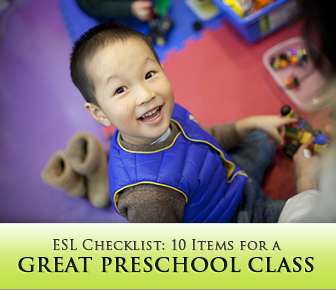If you think that teaching preschoolers is a piece of cake just because they learn the alphabet, colors and a few simple phrases, think again!
It takes a great deal of patience and commitment to teach little ones a second language. Yes, they will enjoy it and yes, they have fun learning new things, but you have to plan your lessons just right and mix in the right ingredients to obtain that perfectly balanced preschool ESL lesson. And what are these ingredients, you ask? Let’s see.

10 Items for a Great Preschool ESL Class
-
1
Are you singing songs?
It is tremendously helpful with preschoolers to have songs that you sing for specific purposes for example, at the start when you say hello, at the end to say goodbye, any time they need to tidy up the classroom and pick up toys, etc… Songs not only help them learn vocabulary, like “Head, Shoulders, Knees and Toes”, they also help you with classroom management.
-
2
Are you using realia?
Enough can’t be said about the benefits of using realia in the ESL classroom, but with preschool learners, it is absolutely essential. You need to have a good inventory of toys, animals, plastic food items, clothes, etc…as many things as you can have. Realia can be used for games, drilling and even testing.
-
3
Are you planning several short activities?
Each lesson needs to be planned as a series of very short 3-5 minute activitiesIf you think you can plan one 20-30 minute activity with preschoolers, clearly you’ve never taught preschoolers. Young learners have a very short attention span; they’re restless, get bored easily, change moods in an instant. Each lesson needs to be planned as a series of very short 3-5 minute activities. That’s a lot, you’ll say, but these activities include singing the hello and goodbye song, as well as others that may repeat daily.
-
4
Are they moving?
Young learners also need movement – it is how they explore their surroundings and learn from them. Total Physical Response (TPR) is a wonderful strategy with preschoolers and the opportunities for learning through movement are great. Even if you have a small classroom, there are lots of things they can do to move while sitting or standing in one spot.
-
5
Are you constantly revising/recycling?
You’ll be amazed at how quickly preschoolers learn – and how quickly they seem to forget it all the next day. Every day you must try to review/recycle what they learned the day before, and expand to include more information. For example, first you teach them how to say classroom objects. The next class, you review classroom objects and teach them prepositions of place. The following day, you teach them how to ask each other for something: Can I borrow your pen? – Sure! It’s on my desk. And so on.
-
6
Are you playing games?
Naturally, preschoolers will love playing games in class. But it’s not just about having fun. Don’t forget there are plenty of teaching opportunities here as well.
-
7
Are you planning both high-energy and quiet activities?
Within the set of short activities you have planned for your class, you need to have some high-energy games and activities (like a race, or singing and dancing), as well as quiet activities that will give them the chance to settle down when they’re being too boisterous. High-energy activities are fun, but quiet tasks give them the chance to take a little breather before the next high-energy activity.
-
8
Is there room for flexibility?
You always need to have a Plan B, a quick solution you can automatically go to when something goes wrong.What happens if you propose a game nobody wants to play? Or nobody understands? What if one of them is upset and starts to cry, and you need a few minutes to help him/her calm down? Lots of things can go wrong in a room full of preschoolers. You always need to have a Plan B, a quick solution you can automatically go to when something goes wrong. So your new game isn’t working and you have a room full of mopey faces. Switch instantly to their favorite game (to practice the same thing), and you’ll hear a room full of cheers. Try to have a worksheet ready or any quiet activity they can do on their own when you have to deal with one student in particular.
-
9
Are the parents participating?
This question is a biggie. Do your students’ parents have any idea what you’re doing in class? Well, they should! Some may talk to you before or after class, others won’t, but they all need to see some evidence of how much their little ones are learning. Send notes to parents in the children’s notebooks: Today we learned colors in English! Send home crafts and drawings – anything they make in class. Ask parents for materials like old magazines, and odds and ends you can use in class.
-
q
Do you have classroom rules in place?
A classroom full of preschoolers with no classroom rules is a ticking time bomb that can go off any second. Children can get very emotional, overexcited, jealous, competitive, and the list goes on. But the important thing is not to give them a list of rules they must abide by, but rather make your own rules together.
Combine all of these ingredients, and you can’t go wrong. You’ll have a preschool ESL class everyone loves!
Have I forgotten anything?
If so, let me know below!
P.S. If you enjoyed this article, please help spread it by clicking one of those sharing buttons below. And if you are interested in more, you should follow our Facebook page where we share more about creative, non-boring ways to teach English.







